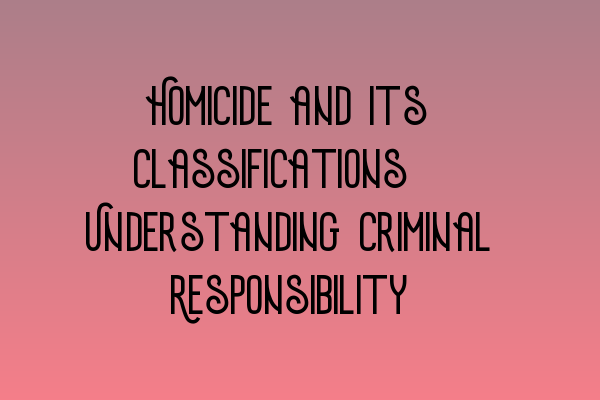Homicide and its Classifications: Understanding Criminal Responsibility
When it comes to criminal law, one of the most serious offenses is homicide. Homicide refers to the act of causing the death of another person. Understanding the different classifications of homicide is essential when determining criminal responsibility and appropriate legal action.
What is Homicide?
Homicide is the deliberate or unlawful killing of one person by another. It covers a wide range of scenarios, from intentional acts of violence to unintentional—but still criminal—acts that result in someone’s death. Homicides can be classified into several categories, each with its own set of legal implications.
1. Murder
Murder is the most serious form of homicide. It involves intentionally causing the death of another person with malice aforethought. Malice aforethought refers to an intention to cause death or serious harm, or acting in a way that exhibits a reckless disregard for human life. Murder convictions carry severe penalties, including long prison terms and, in some cases, life imprisonment.
To learn more about murder, its legal elements, and the various degrees of murder, check out our article on decoding criminal evidence rules.
2. Manslaughter
Manslaughter is the act of causing another person’s death without premeditation or malice aforethought. It differs from murder in that there is no intention to cause death, although the act is still considered criminally negligent. Manslaughter can be divided into two main categories:
- Voluntary Manslaughter: Voluntary manslaughter occurs when a person intentionally causes the death of another in the heat of the moment, typically due to a sudden provocation. The provocation must be strong enough to lead a reasonable person to lose control.
- Involuntary Manslaughter: Involuntary manslaughter is the unintentional killing of another person, usually as a result of criminal negligence or reckless behavior. This can include cases where the person did not intend to cause harm but acted irresponsibly.
For a more in-depth analysis of manslaughter, including the distinctions between voluntary and involuntary manslaughter, refer to our article on updates in UK criminal laws.
3. Infanticide
Infanticide is a unique form of homicide that involves the killing of a newborn child by their mother. It is a specific offense that takes into account the mother’s mental state following childbirth. Sentencing for infanticide is typically less severe than for murder or manslaughter, recognizing the complex emotional and psychological factors involved.
4. Corporate Manslaughter
Corporate manslaughter applies to organizations rather than individuals. It occurs when a corporate entity’s gross negligence or serious management failures result in the death of a person. Corporate manslaughter carries significant penalties, including substantial fines and potential reputational damage to the organization.
If you’re interested in learning more about corporate manslaughter, take a look at our workshops and seminars on criminal practice.
Conclusion
Understanding the different classifications of homicide is crucial for comprehending criminal responsibility and the appropriate legal consequences. Murder, manslaughter, infanticide, and corporate manslaughter each have their own unique characteristics and implications. To prepare yourself for the SQE Criminal Practice exam and expand your expertise in criminal law, consider taking our mock tests for SQE Criminal Practice and join our SQE Criminal Law study group.
